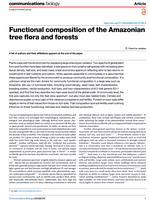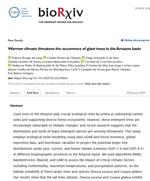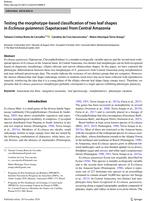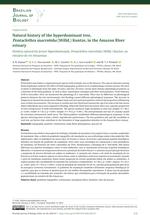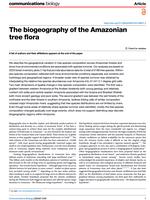Caroline C. Vasconcelos
Research Fellow
INPA Herbarium, Instituto Nacional de Pesquisas da Amazônia, Brazil
Bio
I hold a Bachelor’s degree in Forest Engineering from the Universidade do Estado do Amapá (UEAP) and Master’s and Doctoral degree in Botany from the Instituto Nacional de Pesquisas da Amazônia (INPA).
During my undergraduate studies, I collaborated for four years on research projects at Embrapa Amapá, where I acquired experience in plant-pathogen interaction epidemiology, morphological and physiological aspects of seeds, seedling growth of tree species, and forest ecology and management for the sustainable use of floodplain forests in the Amazon estuary.
Recently, I worked as a research fellow funded by CNPq (DTI-A) in the Ecology, Monitoring, and Sustainable Use of Wetlands (MAUA group) at INPA, where I gained experience in floristic inventories, botanical identification, and collecting functional trait data for tree species in Amazonian ecosystems.
I am an associate researcher at INPA’s Seed Lab, where I have been conducting and co-supervising morphological and taxonomic studies on Amazonian Sapotaceae, Lecythidaceae, and Copaifera (Leguminosae) since 2015. Additionally, I am working on a taxonomic revision of the Neotropical genus Ecclinusa (Sapotaceae).
I am currently a research fellow on a project to popularize infrared spectroscopy for the recognition of tree species (Spectra Pop) at the INPA Herbarium, funded by FAPEAM and coordinated by Dr. Flávia M. Durgante.
My main research interests include taxonomy and systematics (with a focus on Neotropical Sapotaceae), Amazonian tree flora, spectroscopy as a tool for tree species identification, species distribution modeling, floristic studies, and forest ecology.
Download my CV (en) or CV (pt-br) for full details.
- Sapotaceae
- Taxonomy and systematics
- Plant spectroscopy
- Seedling morphology
- Floristic studies
- Amazonian flora
- Herbarium
- Tropical forest ecology
- Species distribution modeling
- Climate change
-
Doctoral degree in Biological Sciences (emphasis in Botany), 2018 - 2024
Instituto Nacional de Pesquisas da Amazônia (INPA)
-
Master's degree in Biological Sciences (emphasis in Botany), 2015 - 2017
Instituto Nacional de Pesquisas da Amazônia (INPA)
-
Bachelor's degree in Forest Engineering, 2010 - 2014
Universidade do Estado Amapá (UEAP)
Research History
See my CV for a full list
Tools & Skills
Software used daily
ArcGIS and QGIS
Geospatial Conservation Assessment Tool
Word, Excel, and PowerPoint
Photoshop and Illustrator
ImageJ and ReColNat Annotate
Portuguese (mother tongue), English (intermediate), French (beginner), and Spanish (beginner)
Five Most Recent Publications
For a full list, including under review and in press publications, please see my CV
Featured Publications
For a full list, including under review and in press publications, please see my CV
Projects
Navigate to a project to see associated publications
Honors, Awards & Grants
See my CV for a full list
Contact
Feel free to send an email to cc_vasconcelos@hotmail.com
- Av. André Araújo 2936, Manaus, AM 69067-375
- Instituto Nacional de Pesquisas da Amazônia
- Follow me on Twitter
- Follow me on Instagram
- Skype Me
